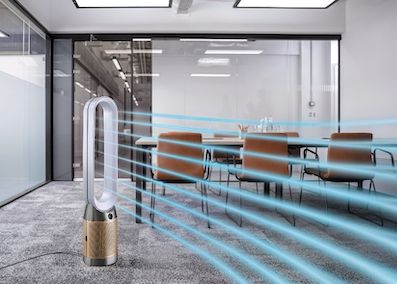 Cleanzine: your weekly cleaning and hygiene industry newsletter 10th July 2025 Issue no. 1170
Cleanzine: your weekly cleaning and hygiene industry newsletter 10th July 2025 Issue no. 1170
Your industry news - first
The original and best - for over 20 years!
We strongly recommend viewing Cleanzine full size in your web browser. Click our masthead above to visit our website version.
Why air purification in the workplace is important this allergy season and how to achieve it…
 By Dyson Professional
By Dyson Professional
“Conversations around air pollution and the dangers and health risks attributed to it have been commonplace for several years now, with many regulations already in place to lessen its dangers. In comparison, its counterpart of indoor air quality is a largely under reported and under researched topic - until now.
Most recently, the UK's chief medical officer, Professor Chris Whitty’s annual report published in December 2022 highlighted the importance of prioritising indoor air pollution as an obvious next step after the improvements made to outdoor air pollution. Paired with the fact that people spend 80% of their time indoors, indoor air quality has become a far more prevalent topic in the current news cycle - especially considering that indoor air pollution can be up to five times more polluted than the air outside.
Moreover, the importance of ventilating indoor spaces to prevent the spread of disease has been emphasised over recent years which has led to the general public's heightened awareness of the air circulating in their indoor spaces, whether communal or private.
With this in mind, keeping windows open to allow natural air flow through an indoor space is often the most common solution. However, this can come with its own risks and problems as outdoor air is not necessarily cleaner or more hygienic and can carry in allergens, especially as we head into warmer months and pollen begins to be released into the air. The issue therein lies with the particles in the air itself: viruses, pollutants, and allergens being amongst some of the main harmful particles.
Therefore, simply opening a window and letting the outside air flow through an indoor space is not always the best answer. As we come into the warmer months of the year, airborne allergens are more common and, as summer temperatures rise, so can pollution levels. More action is needed to improve air quality in the spaces we are able to control in order to mitigate the effects of pollutants.
As we get into springtime, it signifies the start of days getting longer, the weather getting warmer, and of course flowers beginning to bloom - a time of year many look forward to. However, for the 26% of adults in the UK who are diagnosed with hay fever, this means the start of allergy season. As an airborne allergen caused by pollen from trees and plants, the outdoor air is filled with these particles that cause harm to those that suffer from the allergy. In addition, 49% of people report experiencing hay fever symptoms - from itching noses and burning eyes, the symptoms are not only uncomfortable but can impact quality of life, affecting everyday life and lowering quality of sleep. Furthermore, hay fever is not just a once off: hay fever season usually lasts several months starting in March through to September, and this year it has started earlier than ever in February.
For those who struggle during this period, simply opening a window to ventilate their indoor spaces is clearly not an adequate solution. The allergens do not just stay outdoors: pollen can be carried on hair and clothes indoors. Keeping the windows and doors closed may seem like the pollution is being shut out - but it is just being trapped in.
The air purification solution…
Removing and destroying the particles themselves to purify the air is one of the most efficient solutions to tackle the problem. Air purifiers are amongst the best ways to trap and destroy the pollutants in indoor spaces we can't see whilst circulating clean air back out. HEPA filters can capture 99.95% of particles as small as 0.1 microns, preventing them from leaking back into the air and the activated carbon in air purifiers can absorb gases, odours and chemicals.
Allergens are of course not the only indoor air pollution particles to be worried about - most harmful particles cannot be seen or smelled but can definitely affect both our physical health and cognitive performance. Alongside pollen and other allergens, particles such as bacteria, industrial emissions, chemical emissions, and other ultrafine particles can all be present in a wide range of indoor spaces; and the smaller the particle, the bigger the problem.
With a large majority of the population spending time in office buildings, education settings, care homes, and other shared indoor spaces, it is of vital importance that users of these facilities are not being negatively affected by the polluted indoor air.
Air purifiers are the most clear-cut way to trap most of these particles and replace them with clean air, ensuring the health and performance of those in the space. It is important for businesses across all sectors to not only be aware of the issue but show that they are doing all they can to provide an adequate solution, signposting to its users that they are putting the health and safety of its customers first.”
27th April 2023







